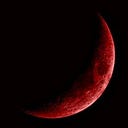Yes, the sky is different from one world to another, and by “world” I mean planet. I picked Mars for an example since it might be the most familiar planet for us second to earth. Actually, the reason behind Mars’ blue sky at sunset is quite similar to Earth’s red sunset. Simply, the concepts are similar but the events are different.
First of all, we need to get a grasp on the sunlight itself. The sun radiates all colors which creates its’ white color. Decomposition or scattering of the sun’s spectrum can be observed through a very familiar natural phenomenon; rainbow. A rainbow separates the sun’s white color into many visible light colors. Below is the diagram of those visible light colors.
Familiar, isn’t it? Now let’s see what really happens on our ordinary Earth day and sunset. The earth has an atmosphere which mainly consists of nitrogen and oxygen molecules. These particles plays important role in the previously mentioned “scattering” effect. When a light wave passes through the Earth’s atmosphere, it is going to interact with these flying particles in three possible way. The light wave is either going to be:
- reflected back
- scattered all around
- passed through
During daylight on Earth, the penetrating sunlight’s blue wave is scattered by the atmosphere. Since blue light has shorter wavelength compared to red light, blue light has higher energy level. Roughly said, it’s just “stronger” than red light. Since the traveling path of the sunbeam is quite orthogonal to the Earth’s surface during daylight, the sunbeam doesn’t really need to travel far distance to reach the ground (well, it’s still a far distance tho but we’ll get into it in a minute). Take a look at this figure below to help yourself visualize what am I blabbering about.
The combination of the sunbeam’s traveling path during daylight and the Earth’s atmosphere scatter blue light waves all over the place. The angle between the sunbeam and Earth’s surface creates a nearly inescapable “trap” to the scattered blue waves and those blue waves dominate the daylight sky on Earth. That is why our daylight is blue.
Now the sunset is red because of the same reason; the combination of the sunbeam’s traveling path during sunset and again the Earth’s atmosphere. The sunbeam takes further distance and sharper angle relative to the Earth’s surface during sunset. Take a look at this figure below.
The blue waves are swirling around the place where the angle between the sunbeam’s path and the Earth’s surface is less sharp. The sharper the angle gets, the scattered and shorter light waves are sort of “left behind”, never to reach any further distance. The red waves however, manage to pierce through the atmosphere during sunset on that specific region on Earth’s surface because they are “less scattered” and more like “passed through” by the atmosphere. And that IS the reason behind our Earth’s blue days and red sunsets.
But what about Mars? Well, apply the same concept of interaction between the sunbeam and the atmosphere. The sunbeam is quite the same no matter where you stand inside our beloved solar system. Mars’ atmosphere is what makes the result different. Martian atmosphere doesn’t mainly consists of nitrogen and oxygen like here on our Earth, but dust particles, mainly iron oxide (a.k.a “rust”, yes, that well known rust on iron) instead. Different particles have different properties such as size, mass, density, color, etc. The difference in those properties create different outputs when given the same input. In this case, the input is the sunbeam and the output is the color of the planet’s sky and sunset. Mars’ red surface is also caused by the iron oxide compound and some of the particles escaped and created Martian atmosphere, which of course is also reddish. An object can be seen red because it reflect red light waves to its’ observer. Since trillions of “objects” such as iron oxide particles also reflect red light waves, red light waves are all over the place. No wonder that Mars’ daylight sky is red.
And now about the sunset on Mars. On the contrary to what happens on Earth, the red light waves are the first to be scattered due to sharper angle between the sunbeam’s traveling path and the surface of Mars. The end result? The red light waves are “left behind” while the blue light waves managed to reach that specific region on the planet which is considered experiencing sunset and that IS the reason why Martian sunset is blue.
In the end, I personally couldn’t care less about this whole light scattering stuff. I’m just curious and now that I know the answer it’s just,“Well…huh?” Some of you might be interested or feel challenged to dig deeper than whatever is written down here in this post, your choice. I’m satisfied already. Scientific stuff aside, I still admire the beauty of our Earthly sunset and that admiration now includes the surreal Martian blue sunset. There’s always a personal taste of romance in watching the sky at sunset even after I know what’s behind the colors. As Sagan said,”It does no harm to the romance of the sunset to know a little bit about it.” Last but not least, here’s a picture of a Martian sunset taken by one of NASA’s probe. Enjoy.
